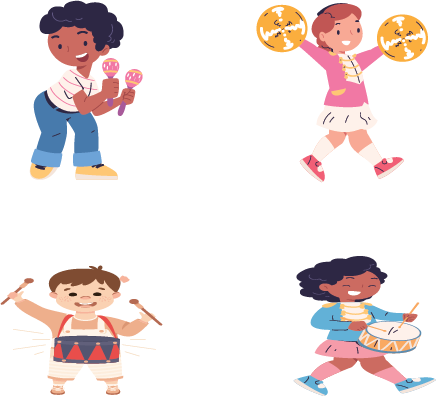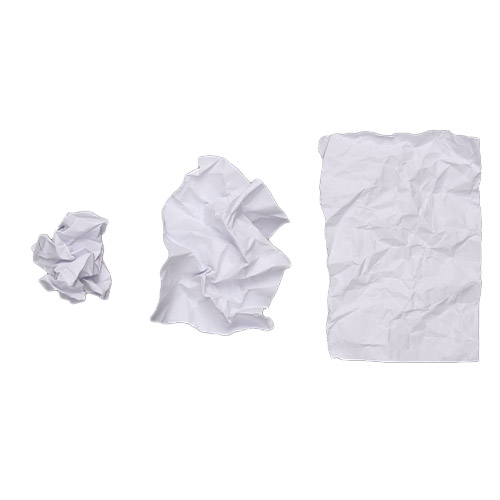
Prep. Lesson 23. Different sounds II
- Non-tuned percussion, tennis balls, pencil, paper Difficulty:
 Prior learning: None
Prior learning: None
![]()
Students will explore pitch and movement through physical, visual, and vocal representations of pathways inspired by animal movements.
- Project or print the pitch pathway maps for each animal and explain how they reflect the animal's movement.
- For example, a bee’s pathway might be a squiggly line (continuous pitch), or a kangaroo's pathway might be a zigzag (pitch hopping up and down).
- Spread out the animal cards and pitch pathway maps. Students work in pairs or groups to match each animal card to the correct pitch pathway.
- Hand out tennis balls to each child. Using the tennis ball, demonstrate how to "draw" a pathway in the air, matching the animal's movement and pathway. Encourage children to replicate the pathways individually.
- Introduce the idea of matching vocal sounds to the pathways, using pitch to mirror the shape (e.g., rising and falling sounds for the rabbit’s hops). Practice as a class, ensuring everyone can connect the movement to a vocalisation.
- Choose a volunteer to draw a pathway in the air with their tennis ball while vocalising the corresponding pitch. The rest of the class guesses which animal the student represents. Rotate through multiple volunteers to give everyone a turn.
- Extension: For an added challenge, have students create animal pathways and pitch representations and share them with the class so others can guess.
 Success Criteria
Success Criteria
- I can match animal cards to their corresponding pitch pathways.
- I can replicate pitch pathways by drawing shapes with a tennis ball in the air.
- I can use my voice to represent pitch pathways and match them to the correct animals.
![]()
Students will develop their understanding of beat by playing non-melodic percussion instruments and engaging in rhythmic improvisation and echoing.

 Success Criteria
Success Criteria
- I can play my percussion instrument on the beat while chanting.
- I can listen to and repeat a rhythm played by a classmate.
- I can improvise my own rhythm confidently for others to echo.
- Start by walking around the room on the beat, as practised in the previous lesson. Encourage children to step in time with a steady beat.
- Once the students are confident, have them sit in a circle. Distribute a variety of non-melodic percussion instruments to every student.
- Introduce a simple chant. Lead the class in chanting the rhyme while playing their instruments on the beat.
- At the end of the fourth line of the chant, invite a student to improvise a rhythm for 8eight beats. Then, allow the rest of the group to use their instruments to echo the rhythm for the next 8eightbeats.
- Continue with the chant, playing on the beat. After the following four lines, select a new student to improvise. Repeat this process several times to allow multiple students to improvise and lead.
- Extension: To add a challenge, vary the tempo of the beat or introduce dynamics (loud/soft) during the activity. Encourage students to incorporate these variations into their improvisations.
![]() Students will explore how everyday sounds can be used to create music and develop their understanding of different sounds.
Students will explore how everyday sounds can be used to create music and develop their understanding of different sounds.
![]() Lyrics
Lyrics
We're making a band of sounds.
We don't need no instruments
A band of sounds.
We don't need no instruments.
 Success Criteria
Success Criteria
- I can learn and sing the song confidently.
- I can create sounds using objects around me.
- I can describe and compare the different sounds I created and heard.
- Teach the song line by line using the echo method. Sing a line and have the students repeat it to you until they are confident in their understanding of the song.
- Explain that any sound can be made into music if used intentionally as part of a beat or rhythm. Tell the students they will create a “band of sounds.”
- Have everyone select a place to stand around the room. Encourage them to stand near objects like tables, walls, or chairs.
- Sing the song together as a group.
- At the song's end, ask each student to create a sound using whatever they stand next to.
- They could scratch a table, flick a wall, or tap a chair leg. (Optional: Students may use chopsticks to create their sounds.)
- Invite two students to demonstrate their sounds to the class.
- Sing the song again. This time, have the students march to the beat while singing and then stand next to a new object in the room. Encourage them to experiment with creating a different sound.
- Repeat the process several times, allowing students to find and explore new sounds.
- Ask what some of the interesting sounds they found were. Were they surprising or not? Did you like the sounds you created?
- Emphasise that not every sound is the same, and that is what makes music interesting and diverse.
- Extension: Have students combine their unique sounds to create a short group performance, layering their sounds in different patterns to explore rhythm and timbre further.
![]() Students will use paper to explore and create various sounds, fostering an understanding of how everyday objects can produce unique sounds.
Students will use paper to explore and create various sounds, fostering an understanding of how everyday objects can produce unique sounds.

 Success Criteria
Success Criteria
- I can find at least three different sounds using a single sheet of paper.
- I can share one unique sound with the group.
- I can listen to and appreciate the variety of sounds created by my classmates.
- Have every student sit in a circle and give each a single sheet of paper.
- Explain the challenge: they must explore the paper to find at least three different sounds they can make.
- Examples might include crumpling, flicking, or tapping. Emphasise that they are only allowed to use one sheet of paper and must avoid destroying it.
- Allow students a few minutes to experiment and discover their sounds.
- Go around the circle and invite each student to share one sound they’ve found.
- Encourage them to listen carefully to the person before them and try to offer a different sound. Ideally, the group will produce a variety of unique sounds.
- Once everyone has shared, discuss the activity.
- What was their favourite sound, and why?
- Were they surprised by the variety of sounds the paper could make?
- Extension: Challenge the group to create a short "paper orchestra," in which students use their chosen sound to contribute to a group rhythm. Then, practice combining their sounds into a coordinated performance.
![]() Students will interpret graphic notation to create music using paper sounds and work collaboratively to perform as a group.
Students will interpret graphic notation to create music using paper sounds and work collaboratively to perform as a group.
 Success Criteria
Success Criteria
- I can interpret symbols on a graphic notation grid and play the corresponding paper sounds.
- I can play my part in time with the class to create a group performance.
- I can finish my part at the same time as everyone else in the group.
- Introduce the concept of graphic notation by displaying a 4x4 grid, with each square containing a symbol representing a specific paper sound.
- Explain each symbol and demonstrate the corresponding sound.
- Ask students to guess what the symbols might mean. Play each sound as a class to clarify and confirm the meanings.
- Play one line of the grid together as a class. Start with a steady beat, counting aloud (e.g., “1, 2, 3, 4”), and ensure everyone plays the correct sound in rhythm. Repeat until the group is confident.
- Divide the class into four groups. Assign each group one line of the grid to follow. Explain that each line represents their part in the piece.
- Practice as a class. The teacher counts a steady beat aloud while each group follows their assigned line. Ensure all groups play in sync and finish at the same time.
- Perform the full piece together. Count the beats aloud for the first few rounds, then let the class play without vocal guidance.
- Discuss the performance. Did everyone finish together? How did the different paper sounds work together to create the music? What could be improved for the next performance?
![]() Students will work collaboratively to create and perform their own paper music compositions using graphic notation.
Students will work collaboratively to create and perform their own paper music compositions using graphic notation.
 Success Criteria
Success Criteria
- I can contribute to my group’s composition by suggesting symbols and sounds.
- I can interpret the symbols in the grid and play the corresponding sounds accurately.
- I can perform my part of the composition in time with my group.
- Divide the class into groups of four.
- Explain that each group will create their own 4x4 paper music composition using graphic notation.
- Provide each group with a blank 4x4 grid and pencils.
- Instruct them to assign symbols to different paper sounds they create (e.g., flick, rub, clap, wave). Groups should agree on the symbols they will use.
- Allow groups to fill their grids with symbols to represent their chosen sounds.
- Once the grid is complete, each group practices their composition.
- Encourage them to count the beat together to stay in time and ensure they finish as a group.
- Invite each group to perform their composition for the class.
- The rest of the class can listen and observe, identifying the sounds and how they align with the grid.
- After all performances, discuss the activity.
- How did the groups decide on their sounds and symbols? What challenges did they face in performing their compositions?
![]() Students
Students
Suggested lessons
Y1. Beat II

Y1. Beat III

Y1. Beat IV

